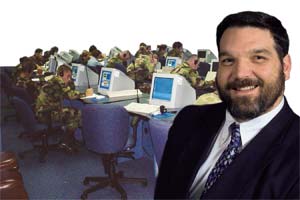
COMPUTERS AND VCRs were connected to SMART boards at DLI.
| INNOVATION: | INNOVATOR: |
|---|
| Bringing Digital Technologies into the Immersive Foreign Language Classroom | Defense Language Institute
Foreign Language Center |
Challenge
At the Defense Language Institute Foreign Language Center,
Monterey (CA), Dr. Jack Franke (a professor of Russian and coordinator of the
European and Latin American School) and his colleagues realized that using digital
technologies in foreign language classrooms would offer new possibilities for
learning, as well as efficiencies for the institute.
The appearance of portable MP3 players in 2002 prompted a search for a complete
technology solution. The main challenge identified was to convert existing analog
technologies to digital ones.To put this conversion into perspective: Previously,
students were issued Walkmans with about 200 audiotapes; today, they are issued
an MP3 player and 12 to 15 CDs. The cost savings is more than a hundred dollars
per student. Each year, the center trains 3,200 students from the armed forces
in up to 75 languages and dialects.
Technology Choice/Project Design
One of the major technology components was to be the SMART board from SMART
Technologies (www.smarttech.com).
The institute had considered GTCO CalComp’s InterWrite SchoolPad, but SMART
boards had already been deployed in DoD and “We went with the tried-and-true,”
Franke explains. The Defense Language Institute is the largest foreign language
institute in the United States; consequently, it was not feasible to install
500 SMART boards in a short time. The project design called for those schools
that had begun the digitization project earlier to receive the interactive whiteboards
first.
The project evolved in three stages.TEC-1, the first phase of the Technology-Enhanced
Classroom project, incorporated a portable SMART board and LCD that could be
moved between classrooms. TEC-2, the second phase, was the intermediate stage
during which SMART boards were installed into each classroom over 15 months.
A computer and VCR were connected to each SMART board. TEC-3, the third and
present phase, is the inclusion of notebooks in the classroom for collaborative
learning and taskbased instruction, along with a wireless networked campus.
Key Players
The key beneficiaries are both students and faculty. Textbooks were
digitized into Acrobat format and MP3 files were embedded into the books. All
exercises and laboratories were digitized in MP3 format and linked to manuals
or textbooks. Rather than search through boxes of more than 500 tapes, the instructor
can immediately find a given sound file or book electronically on the server.
Results
This project resulted in huge savings in time and money, both of which savings
are invaluable in an institute that intensively teaches seven hours a day, every
single day of the year. Instructors can now send textbooks and sound files across
the globe instantaneously and distribute entire courses on a couple of DVDs.
The single biggest impact of the project is the ability to use digital files
in any classroom or laboratory, anywhere on the campus network. There are also
“teacher folders” for all the instructors, and a cross-fertilization process
that takes place among faculty within the school and the institute, to develop
best practices.
Surprises
Franke says that the biggest surprise was the amount
of storage necessary for digitizing audio and video to be accessed on the server.
But the biggest obstacle was the learning curve of the faculty, most of whom
are immigrants from countries around the globe.
Next Steps
Presently, the institute is deploying TEC-3, the third phase of the Technology-Enhanced
Classroom project, in which Franke hopes to eventually see wireless networks
in use in the classrooms. Of critical importance is the need for information
assurance, and the institute must remain vigilant in protecting the networks
from hackers and predators.
The next steps are continued training of faculty, integration of new technologies
into the project, and developing programs such as LingNet (www.lingnet.org)
to satisfy specific needs and goals. The institute is building a data center
to enable connections throughout the campus and to its graduates. Finally, the
institute is building a Broadband Language Training System that will incorporate
a high-speed broadband network and allow for a Learning Management System for
both resident and non-resident training.
Advice
“I would advise others to build
technical support into the equation from the very beginning,” says Franke. “It
is imperative that you have backups when Murphy’s Law rears its ugly head; otherwise,
technology becomes a disability.” He also suggests that if support is needed,
visit other campuses or schools to see what works and d'esn’t. And plan for
the life cycle of the technology —try not to have to replace everything at the
same time.
Related Links and References
Defense Language Institute Foreign Language Center (
www.dliflc.edu);
The Global Language Network (
www.lingnet.org);
Smart Technologies (
www.smarttech.com);
Foreign Language Portal (
www.ilovelanguages.com);
and the Computer-Aided Language Instruction Consortium (
www.calico.org).